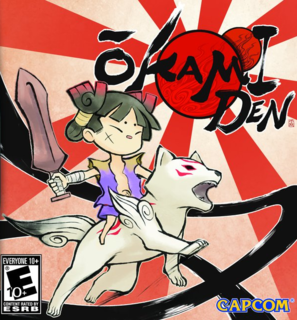A worthy sequel to a legendary game.
The Celestial Brush is the main feature of this game. Throughout the game, you can draw certain shapes to navigate puzzles and defeat your enemies. While there are a couple brush strokes from Okami that are missing, the majority of the important ones are still here. Of note is that, unlike Okami, your ink pots don't automatically regenerate so you should always have some ink replenishing items on hand, especially for boss fights. Also, using your brush during special events will still drain your ink pots, even more so if you mess up and need to redo them. I can't help but think that this was a programming oversight, but it's not a severe issue.
Controls are both good and bad at the same time. Since you're restricted to using the 4-input D Pad for movement, the game frequently forces your camera in a certain position, or in some cases will do turning for you. The good thing about this is that it makes using the D Pad less annoying, yet in the case of the automatic turning it makes it feels like you're on rails. However, the rest of the automatic camera use is surprisingly good as it will generally show you everything you need to see. The combat camera automatically focuses on single enemies, so if you're fighting multiple enemies it might get difficult to see them if they get behind you. The overworld camera is a bit annoying as the only way to turn it is the arrows on the touch screen, so you may find yourself messing with the D-Pad alone to change the camera direction instead.
Combat outside of boss fights is somewhat repetitive. Fights against demons consist of mashing Y repeatedly, then either dodging or using a brush technique, then going back to Y mashing, rinse lather repeat. Despite getting three different weapon archetypes -Reflector, Glaive and Beads- nothing really changes when you change weapons. There's a slight exception with Glaives, as you can charge your attack, but that really only serves to make it the superior boss-killing weapon as you go for fairly long periods of time without being able to retaliate, thus giving you time to charge the Glaive. There's one other weapon type, but that's the secret weapon you get after completing the game and I'd rather not mention it here. Suffice to say though it actually IS different from the rest.
Nevertheless, the bosses themselves are, in my opinion, the highlight of combat as they combine puzzles and some decent reflexes. Even if the game yells at you saying "DO THIS TO KILL THE BOSS", it still mixes things up by throwing extra things in like forcing you to dodge attacks or making you react quickly to sudden changes in pattern. Of note is that there's also one side-scroller-bullet-hell "boss" about midway through the story, which was an excellent way to change up the pace.
Puzzles are scattered throughout the game. Most of these consist of using the Celestial Brush on something, and the rest are located in the dungeons. These puzzles are generally robust, but I do have one gripe with them. Roughly half the dungeon puzzles in the game seem to consist of "lead your partner across the impassable ground, then either fetch an item back or haul yourself over". And this one mechanic is repeated in every single dungeon in the game, with the only difference being the nature of the impassable terrain. There are a handful of times when this is given some variation, like defending your partner while they head somewhere, but by the end of the game the whole process just gets a bit tedious. Thankfully, the other half of the puzzles are nicely varied and make full use of everything you have and then some. I will say though that some of these puzzles are carbon copies from Okami, so if you played that (and I strongly recommend you do if you haven't) then these will cause you to either grin or cringe.
And now for the juicy part: the story. This story is fully fleshed out and does everything from developing all the important characters to making little nods to Okami. When you start out you might think that some parts of the story were lazily overlooked, but I assure you that everything will come to a satisfactory conclusion by the end of it. Well, except for a few bits at the very end, but it's obvious those were put there on purpose for a potential sequel. The nods to Okami would be easily overlooked if you never played the original, and therefore won't kill the immersion, but if you did and can still remember those parts then I'm sure you'll be grinning.
Aside from the main game, there are tons of side quests to take. The big one is Yakushi Village, and throughout the course of the game you'll find people who want to move there. As more and more people arrive, you'll unlock various bonuses such as the Blacksmith (upgrades weapons) and the Shaman (special item store). It should be noted that the game forces you to find certain immigrants, so the Blacksmith and Shaman are definitely available before the end of the game. There are also people who send you on quests to find certain items, and those are found all over the place: random chests, secret areas and even in the middle of dungeons.
In terms of time played, I clocked 16 hours, almost entirely ignoring the side quests. Most people clock around 20 hours while ignoring the side quests, and about 30 in a balanced playthrough of full story and some side quests.
Overall, despite the flaws I'd still consider Okamiden one of the best if not the best portable RPG I've ever played. There's plenty of stuff to do on your first time through, and even more's in store during round two. Hey, that rhymed!

